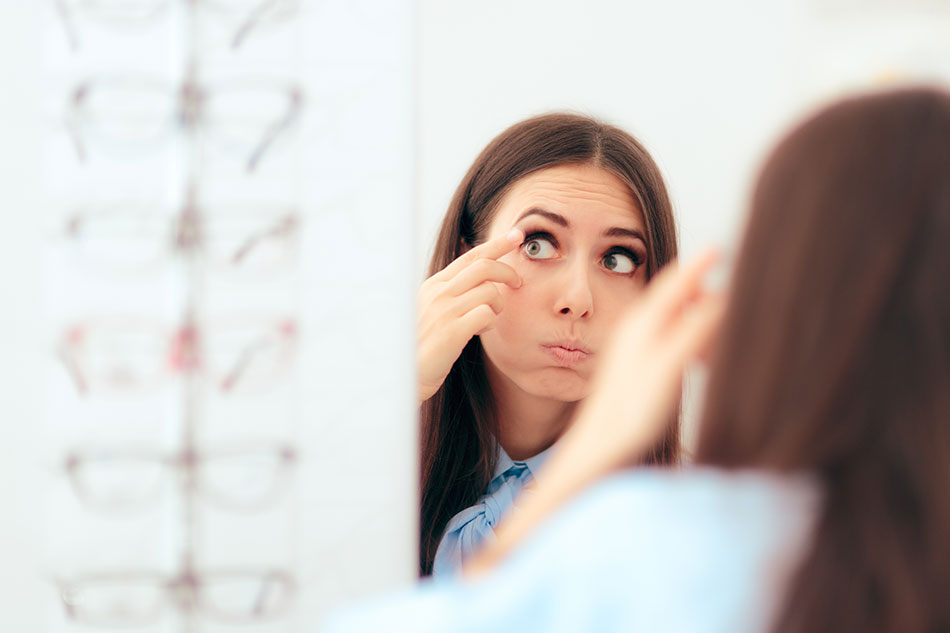Trouble Putting in Contacts: Common Causes and Solutions

Millions of people wear contact lenses every day, but many still experience trouble putting them in correctly. The good news is that most of these challenges have simple fixes. Whether you are new to contacts or have been wearing them for years, understanding what causes difficulty can make the process much easier.
Here are the most common reasons people struggle to insert their contact lenses and practical ways to overcome each one.
Overcoming the Fear of Touching Your Eyes

If you feel anxious about touching your eyes, you are not alone. Many first-time contact lens wearers are nervous at first. The key is to take things slowly and stay calm.
- Give yourself plenty of time and avoid rushing.
- Sit somewhere comfortable and use a mirror with good lighting.
- Wash and dry your hands before handling lenses.
- Practice without pressure. Repetition will help reduce your fear.
Over time, inserting lenses becomes second nature. If your anxiety persists, try practicing with artificial tears first to get used to touching your eyes safely.
Improving Your Technique
Some of the trouble people have with putting in contacts comes from lack of proper technique. But don't worry, it's not as complicated as it sounds! Your eye care professional is a great resource to make sure you’re doing everything right.
By working on your technique constantly, it’ll quickly become second nature. In no time, you won't even think about it.
So what is the best technique for putting in contacts? Obviously, everyone is different, and you’ll find a way that’s most comfortable for you. But these tips can help get you started:
- Make sure your hands are clean and dry.
- Have a regular, comfortable place that you sit at to put your contacts in. That way, you’ll be in the same position each time, at least until you gain some more experience.
- Sit in front of a mirror, with plenty of light.
- Remove the contact lens from the packaging and place it on the index finger of your dominant hand.
- Use your other hand to lift the top eyelid upward and the bottom one downward. Look up toward the ceiling.
- Slowly and gently place the contact lens on the eye and hold it there for a couple of seconds.
- When it feels comfortable, slowly blink.
- If it still feels comfortable and you can see perfectly, you've successfully put your contact lens in!
If your contact falls out when you blink or gets stuck to your finger, don't panic! It’s not the end of the world. These things happen occasionally to many contact lens wearers. Just repeat the technique until it feels comfortable.
Being Aware of Your Contact Lenses
You might feel your lenses more than you should when you first start wearing them. Mild awareness is normal at first, but discomfort or persistent irritation is not.
Here are a few possible causes:
- The lenses may not fit properly.
- There could be debris or buildup on the lens.
- You might be wearing the lens inside out.
If you often feel your lenses, schedule a checkup with your eye care professional. A small adjustment in size or material can make a big difference in comfort.
Burning or Stinging When Putting in Contacts

If your eyes burn or sting when putting in contact lenses, contamination is the most likely cause. Contact lenses easily absorb substances like hand lotion, makeup, or soap residue. These irritants can transfer directly to your eyes.
To avoid this problem:
- Always wash your hands with a mild, fragrance-free soap and dry them thoroughly.
- Make sure your lenses are clean and free of dust or lint.
- Avoid applying lotion or makeup before inserting lenses.
- Use fresh, sterile solution each time you handle your contacts.
If irritation continues, stop wearing your lenses and consult your optometrist to rule out infection or an allergic reaction.
Small pieces of dust or dirt can easily stick to your contact lens and cause similar irritation. Making sure your contact lenses are always clean, or using daily disposable contacts, will solve this issue.
Trouble Caused by Dry Eyes

Dry eyes can make inserting contacts difficult and uncomfortable. Without enough natural moisture, lenses may not adhere to your eyes properly.
Dryness can be caused by:
- Air conditioning or low humidity
- Allergies
- Certain medications
- Dehydration, caffeine, or alcohol
- Prolonged screen time
To help with dryness:
- Use rewetting drops designed for contact lens wearers.
- Take breaks from screens to rest your eyes.
- Drink plenty of water throughout the day.
- Try using a humidifier in dry environments.
If dryness persists, ask your doctor about switching to lenses made for sensitive or dry eyes, or consider daily disposables.
Overcome the Trouble of Putting in Contacts
We’ve reviewed some of the common problems people have with putting in lenses and showed you how to do so without discomfort.
Wearing them shouldn't be an effort, so if you ever have trouble putting in contacts, remember what we’ve outlined here. If you’re not getting past your troubles, speak to your eye doctor. Even talking to a contact wearing friend might help!
FAQ: Trouble Putting In Contact Lenses
Why do I have trouble putting in contact lenses?
Difficulty inserting lenses is usually caused by anxiety, dryness, poor technique, or lenses that do not fit properly. Practice and good hygiene can help.
What should I do if my eyes sting when I put in my contacts?
Remove your lenses immediately, rinse them with fresh solution, and wash your hands thoroughly. If burning continues, stop using them and contact your optometrist.
How can I stop being afraid to touch my eyes?
Start slowly and use artificial tears to practice touching your eyes gently. Over time, your comfort and confidence will increase.
Why do my contacts keep falling off my finger?
The lens may be too dry or have static buildup. Apply a small drop of saline or rewetting drops to the lens to make it easier to place.
Can dry eyes cause trouble when putting in contacts?
Yes. When eyes are too dry, lenses may not stick properly or can feel irritating. Using rewetting drops or choosing daily lenses can help.
